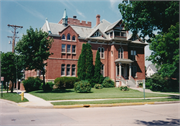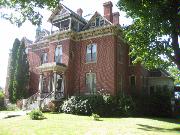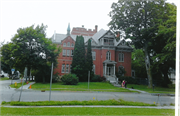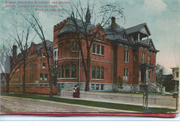Property Record
101 E DIVISION ST
Architecture and History Inventory
| Historic Name: | JOHN AMORY HOUSE |
|---|---|
| Other Name: | CONVENT OF THE HOLY NATIVITY |
| Contributing: | Yes |
| Reference Number: | 16527 |
| Location (Address): | 101 E DIVISION ST |
|---|---|
| County: | Fond du Lac |
| City: | Fond du Lac |
| Township/Village: | |
| Unincorporated Community: | |
| Town: | |
| Range: | |
| Direction: | |
| Section: | |
| Quarter Section: | |
| Quarter/Quarter Section: |
| Year Built: | 1855 |
|---|---|
| Additions: | C. 1895 1904 |
| Survey Date: | 1988 |
| Historic Use: | house |
| Architectural Style: | Italianate |
| Structural System: | |
| Wall Material: | Stucco |
| Architect: | John Amory |
| Other Buildings On Site: | |
| Demolished?: | No |
| Demolished Date: |
| National/State Register Listing Name: | East Division Street - Sheboygan Street Historic District |
|---|---|
| National Register Listing Date: | 4/17/2010 |
| State Register Listing Date: | 2/19/2010 |
| National Register Multiple Property Name: |
| Additional Information: | A 'site file' exists for this property. It contains additional information such as correspondence, newspaper clippings, or historical information. It is a public record and may be viewed in person at the Wisconsin Historical Society, State Historic Preservation Office. Damaged by fire on 6/7/2015. The original portion of this building is a two and one-half story Italianate house with a later added upper half-story of steeply-pitched hipped roof and projecting gables. The round-arched paired window openings sit under round arches. The main entrance consists of double hung doors sitting under an elliptically-arched transom. The addition to the west of the main block has two-and-one-half stories with a two-story tower on the west end wall. Windows are largely multiple sets of double-hung sashes with transoms. On the tower these sets are arched and partially filled in. The large 1904 addition to the north of the building is constructed of red brick with a steeply-pitched hip roof and projecting stepped gables. Openings are double-hung sashes. A three-and-one-half story square tower with battlements connects the older portion of the building with the 1904 addition. It is decorated with buttresses, a bay, and decorative stone trim. The Gothic Revival inspired additions are well executed and add significance to the original house. The original Italianate house was built around 1855 for businessman John Amory, who lived there until around 1890. The house, with the west addition was occupied by Rev. Charles Grafton, the noted Episcopal Bishop of the Fond du Lac Diocese, until the early twentieth century. It has also been home to the Sisters of the Holy Nativity since the late nineteenth century. The building remains a convent today. This building is historically significant because of its long-time association with Rev. Charles Grafton, an important historic figure in the city, and because of its long-time use as a residence for nuns. |
|---|---|
| Bibliographic References: | (A) DATESTONE. (B) 1880 COUNTY HISTORY. (C) FOND DU LAC TALKING HOUSES AND HISTORIC PLACES BROCHURE, FOND DU LAC CONVENTION AND VISITORS BUREAU. (D) FOND DU LAC CITY DIRECTORIES. (E) SANBORN-PERRIS MAPS - FOND DU LAC. (F) TAX ROLLS - FOND DU LAC. Fond du Lac Reporter 1/14/2003. Fond du Lac Reporter 7/27/2003. |
| Wisconsin Architecture and History Inventory, State Historic Preservation Office, Wisconsin Historical Society, Madison, Wisconsin |





